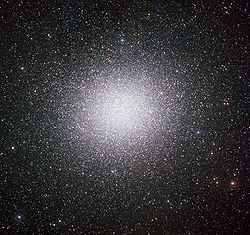Omega Centauri

Omega Centauri ligger i stjernebilledet Centaurus (Kentauren) og er vores galakses største stjernehob. Omega Centauri er, som næsten alle store stjernehobe, en kuglehob.
Man mener at Omega Centauri var kernen af en mindre galakse som Mælkevejen "slugte hel". Og den har en diameter på 150 lysår, hvilket betyder at den er større end nogle få små galakser.
Stjernerne i kuglehoben er så tæt sammenpakket, at hvis der zoomes ind på midten hvor billedet viste 50.000 stjerner, ville et lige så stort område omkring os kun vise 6 stjerner!
Fakta
- Diameter: 150 lysår (1.419.000.000.000.000 km)
- Afstand: 17.000 lysår. (160.820.000.000.000.000 km)
- Antal stjerner: Lidt under 10 millioner.
Eksterne henvisninger
| Spire Denne artikel om astronomi er en spire som bør udbygges. Du er velkommen til at hjælpe Wikipedia ved at udvide den. |
Medier brugt på denne side
Forfatter/Opretter: ESO, Licens: CC BY 4.0
The globular cluster Omega Centauri — with as many as ten million stars — is seen in all its splendour in this image captured with the WFI camera from ESO's La Silla Observatory. The image shows only the central part of the cluster — about the size of the full moon on the sky (half a degree). North is up, East is to the left. This colour image is a composite of B, V and I filtered images. Note that because WFI is equipped with a mosaic detector, there are two small gaps in the image which were filled with lower quality data from the Digitized Sky Survey.
Coordinates Position (RA): 13 26 47.32 Position (Dec): -47° 28' 46.86" Field of view: 31.88 x 29.99 arcminutes Orientation: North is 0.0° right of vertical
Colours & filters Band Wavelength Telescope Infrared B 451 nm MPG/ESO 2.2-metre telescope WFI Optical V 539 nm MPG/ESO 2.2-metre telescope WFIOptical I 783 nm MPG/ESO 2.2-metre telescope WFI
Forfatter/Opretter: Fork of free file File:Celestia.png, Licens: GPL
Image of the planet Jupiter and one of its moons (Io)
This image, a small region in the heart of the Omega Centauri globular cluster, was taken with the Hubble Space Telescope Wide Field and Planetary Camera 2. Omega Centauri is so large in our sky that only a small portion of it could fit in the camera's field of view, but even this region contains some 50,000 stars in an area about 13 light years wide. A similar area located where our Sun resides would contain about a half a dozen stars.




